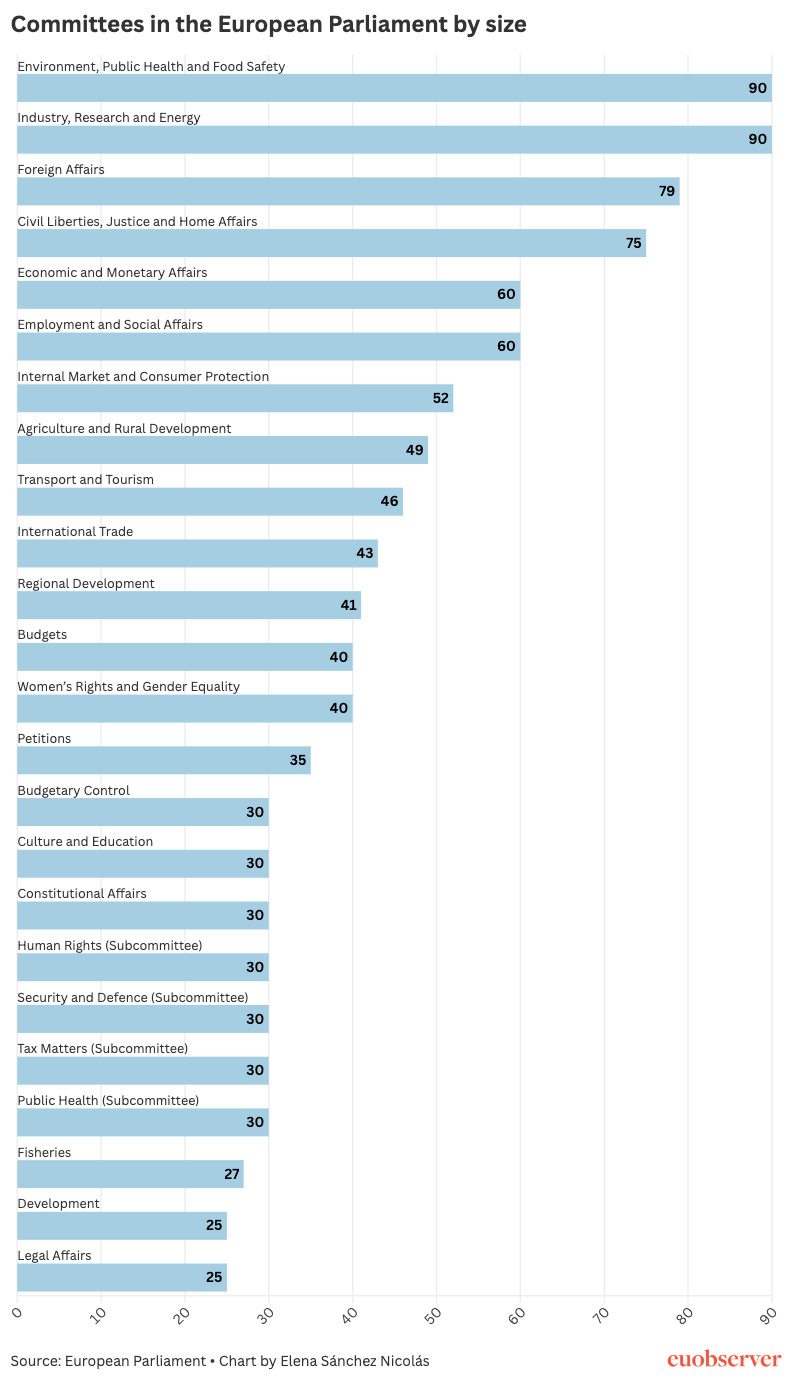Magazine
The new balance of power inside the EU parliament’s ‘engine room’
EUobserver takes a deep dive into the workings and new chairs of every single European Parliament committee for the new 2024-2029 session, in a series of articles first published in our print magazine of October 2024
A total of 720 MEPs represent the more than 440 million citizens in the EU — but it is really within the 20 committees and four subcommittees where the first steps of the political and legislative work of the European Parliament truly take place.
Inside parliament, the various committees’ political power becomes visible only at key moments — such as when they turn down commissioner designates, or when major legislation faces potential defeat. A good example was when the environment committee nearly rejected the controversial EU nature restoration law last year, keeping the Brussels Bubble on edge.
Committees typically meet once or twice a month in Brussels, holding debates and discussions that serve not only to shape the EU’s legislative agenda, but also as an oversight mechanism when, for example, it comes to controlling the proper use of the EU budget.
Their day-to-day work mainly consists of binding “co-decision” on EU laws in areas such as the single market, migration, economic governance, trade, tech regulation and climate change. But their daily tasks also involve non-binding “consultations” on EU decisions such as foreign affairs, taxation or competition law.
While there are currently 24 standing committees and subcommittees, the EU parliament can set up special committees on specific issues at any time for a mandate of one year. (During the 2019-2024 term, for example, several special committees were created, such as those covering foreign interference, the Covid pandemic, AI, and the use of surveillance systems.)
Each committee contains between 25 members (development, the smallest) and 90 (environment and industry, the largest). And their composition always reflects their political weight.
Based on the traditional D’Hondt method, a mathematical formula which determines bargaining power based on group size, political groups among themselves divide committee chairs for a mandate of two-and-a-half-years.
Notably, the majority of chair positions are held by men, with women occupying around 30 percent of these roles heading committees and subcommittees.
All political groups have "coordinators" in each committee who manage their group's position on various files. Along with the chair and vice-chairs, they organise the committee's work.
But committees normally work by electing a “rapporteur” who is the MEP leading the work on a specific file. These rapporteurs are chosen via another complex method in which political groups bid for a report on a concrete subject, as in an auction.
The committees review legislative texts proposed by the European Commission, which also have to be approved by EU member states. They hold public hearings, invite experts, and suggest changes. They can also carry out fact-checking missions if necessary. The rapporteur usually prepares a draft report, which can still be modified, before the full committee votes on a compromise — which is presented to the plenary for final approval.
But committees also get involved in the nitty-gritty of the EU’s law-making machine, participating in the so-called trilogues, where EU diplomats and MEPs negotiate to find common ground on legislation.
The constitutional affairs committee has the highest number of veteran re-elected MEPs, but those committees dealing with trade, development and foreign affairs also have some of the most senior members, according to an analysis by EU Matrix.
Committees focused on budgetary, macroeconomic, and internal market affairs have significant representation from German parties. German MEPs also have a stronger presence than French MEPs in the defence subcommittee.
French lawmakers dominate the international trade and civil liberties committees, while Spanish MEPs are the largest in the fisheries committee.
Polish MEPs have a strong presence in the budgetary committee (key for Poland as a major net beneficiary of the EU budget, and budget-related portfolio for its commissioner nominee Piotr Serafin.)
Meanwhile, Italians dominate the committees on industrial policy and agriculture, while Romanians are well-represented in both the budgetary and regional development committees, alongside French and Germans.
While all committees play key roles in the legislative process, the most important committees typically address economic, budgetary, and foreign policy issues, significantly influencing EU legislation and policies and thrashing out big ideas such as geopolitics and trade agreements.
In contrast, others, such as the culture or petitions committees, wield less influence, focusing on smaller issues such as the Catalan language model in schools or citizen’s petitions over cannabis legalisation or animal welfare regulations.
But they all contribute to the overall functioning of the European Parliament — a collective effort that contributes to a more democratic European Union and promotes the interests of EU citizens.

Author Bio
Elena is EUobserver's editor-in-chief. She is from Spain and has studied journalism and new media in Spanish and Belgian universities. Previously she worked on European affairs at VoteWatch Europe and the Spanish news agency EFE.
Related articles
Tags
Author Bio
Elena is EUobserver's editor-in-chief. She is from Spain and has studied journalism and new media in Spanish and Belgian universities. Previously she worked on European affairs at VoteWatch Europe and the Spanish news agency EFE.